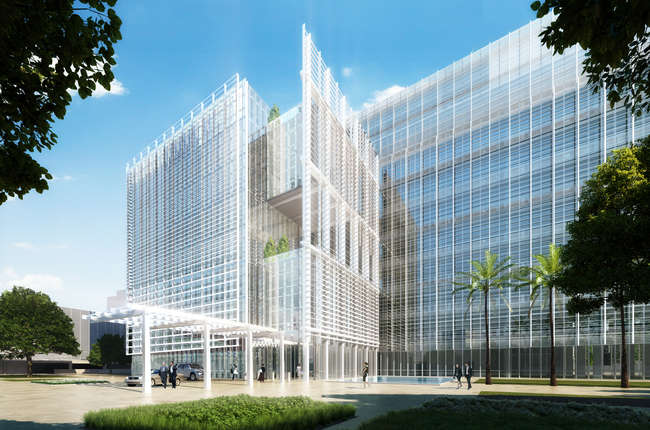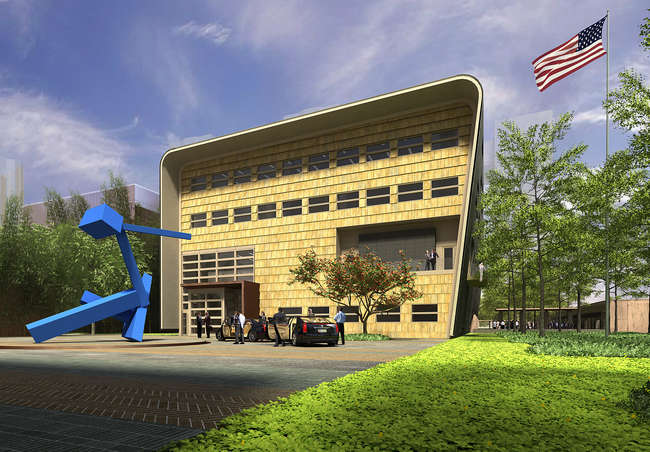
Courtesy Davis Brody Bond Architects and Planners
Davis Brody Bond Architects and Planners' U.S. Embassy in Jakarta is under construction. The project was commissioned before the State Department's Design Excellence program, but embodies the principles of the new initiative.
After years of building standardized embassies and consulates on the edges of cities, focused solely on security and the bottom line, the U.S. Department of State launched an ambitious Design Excellence building program two years ago. It is now coming to fruition. Tod Williams Billie Tsien Architects has been commissioned to design a new Embassy compound in Mexico City with Davis Brody Bond and, last month, Michael Maltzan was selected to design a new residential annex for embassy staff at the U.S. embassy in Paris.

|
|
Courtesy SOM
SOM's U.S. consulate in Guangzhou is slated for completion in spring 2013. Like Davis Brody Bond's embassy in Jakarta, it was commissioned before the new Design Excellence program was formed, but embodies the initiative's principles.
|
The program resembles the one that was intended to showcase American values during the Cold War and produced exemplary embassies by Walter Gropius, Edward Durell Stone, and Eero Saarinen. Over time, however, cultural ambition fell prey to pragmatic concerns. The new Design Excellence program that the Bureau of Overseas Building Operations (OBO) administers, like the domestic Design Excellence program at the General Services Administration (GSA), is garnering exceptional American talent to create State Department buildings tailored to particular locales. The idea is to build in accessible, urban locations using American technology and talent to create secure, inviting, and contextual facilities at a time of rapid cultural change and frequent political unrest.
In light of the recent attack on the consulate in Libya, questions about security and anti-Americanism abroad are part of the discussion around these new embassies. “These events remind us that our work is cultural,” explained Lydia Muniz, the Director of the OBO, at a September panel discussion on the program at Cooper Union in New York. “There is no better way to begin to have the conversation about American values than with architecture. Everyone who comes to an embassy or consulate to get a visa, everyone who walks by” gets an impression of this country from these buildings, Muniz said.
At the panel, Casey Jones, who oversees Design Excellence for the GSA as well as at the State Department, discussed the ways the State Department’s program embodies those values. “We are doing custom built facilities now that make good sense culturally and climatically,” he explained. “We are placing them in urban areas so that people can get there easily, using them as catalysts for urban development on brownfield sites, emphasizing life cycle costs, and creating interiors for the ways people actually work.” Teams of architects, engineers, contractors, landscape architects, and artists are selected on the basis of portfolios, past performance, and, sometimes, design charrettes.
Muniz cited KieranTimberlake’s U.S. Embassy in London, currently under construction, as an example of the new approach, which “solves the problems of security and image and function.” At the Cooper Union panel, KieranTimberlake founding partner Stephen Kieran described the unusually safe and energy efficient crystalline cube in a park-like setting near the Thames, “served by four strands of infrastructure … For us, the security dimension is just another requirement. All buildings have a series of contradictory requirements. That is what we do as architects all the time.”
No program pleases everyone. An architect in the audience at the panel asked, “Given the contemporary thrust of the designs as opposed to the classical vocabulary, won’t there be a backlash?” Muniz replied, “We have to respond to the environment wherever we build.”

Post a comment to this article
Report Abusive Comment